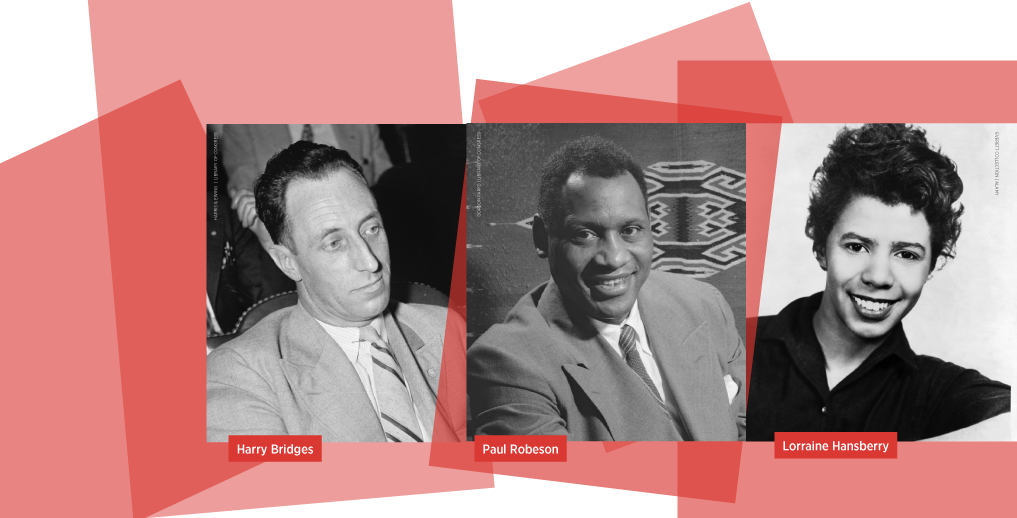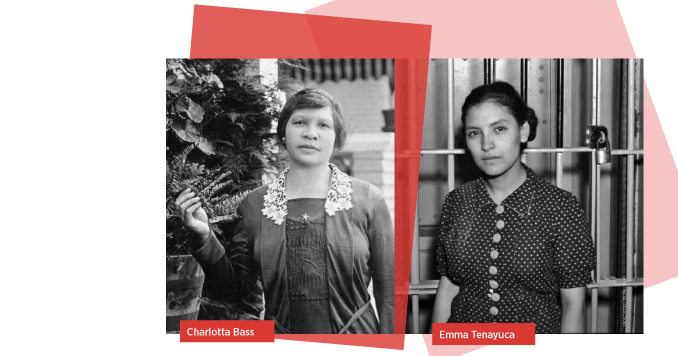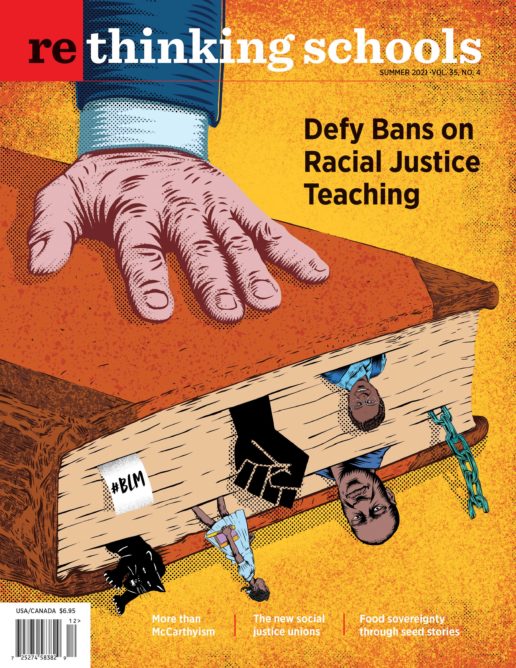More Than McCarthyism
Activists Our Students Deserve to Know

Twelve thousand of the United States’ poorest, most vulnerable workers, the majority of them Mexican American women, walk off their jobs as pecan shellers in Texas. The strike lasts three months, but the workers eventually win a pay increase.
Millions of Americans attend live theater for the first time in their lives — for free! — while tens of thousands of unemployed writers, artists, actors, and stagehands get well-paid, meaningful work during the worst economic crisis in U.S. history.
An African American sharecropper in Georgia, a widow and mother of 12, is sexually harassed and beaten with a gun by a white neighbor. In self-defense, the widow and two of her sons kill the neighbor. The three are tried, convicted of murder, and sentenced to death. A national movement spearheaded by an organization of Black women activists mobilizes to defend the family. They succeed in getting the family’s death sentences commuted.
These are the poignant stories of organizing, activism, and anti-communist repression throughout the 20th century that students are denied when educators hew to the standard version of this history — whose high-water mark is labeled the McCarthy era in most textbooks.
The “second Red Scare,” launched immediately following World War II, was a time when the government and powerful elites conspired to stamp out the efforts of some of the United States’ most dynamic activists and political organizations, like Sojourners for Truth and Justice, founded in 1951 by Louise Thompson Patterson and others. But repression of radical organizing in the United States was never confined to the so-called McCarthy era. Consider the attacks on radical activists like Emma Tenayuca, who led the 1938 San Antonio pecan shellers strike, and Hallie Flanagan, who headed the Federal Theatre Project during the Great Depression. Whenever organizers challenged the status quo — racism, sexism, capitalism, militarism, and colonialism — its defenders screamed “communism.” Our students deserve to know that anti-communist repression has always been about a lot more than Russian spies, a blustering senator from Wisconsin, and a blacklist in Hollywood.
Understating the Scope
The textbook periodization of anti-communist repression, which posits the first Red Scare in the years following World War I, and the second Red Scare in the late 1940s and early 1950s, erases the continuity and pervasiveness of anti-communist politics and policies throughout the 20th century. These ordinal Red Scares suggest to students that anti-communist political repression was exceptional, tightly bound into two discrete decades. But between the Palmer Raids and McCarthy, there were the Fish Committee and the Dies Committee (HUAC), and after McCarthy there was COINTELPRO. Indeed, many of the targets of anti-communist persecution were attacked in more than one era. The FBI surveilled Charlotta Bass, the famous newspaperwoman, from the 1930s (and perhaps even earlier) until she died at 95 years old. Jack O’Dell was first red-baited as a labor leader in the 1940s and ’50s, and then again, when working with the Southern Christian Leadership Conference in the 1960s.
Another problem is the term “McCarthyism,” which makes it virtually impossible not to overstate the centrality of Joseph McCarthy, the man. Textbooks show us photos of McCarthy at a map depicting communist infiltration of the military (National Geographic) and acknowledging the cheers of a crowd of flag-waving supporters (Glencoe). Textbooks tell us that “He drank too much and could get offensive and even violent at times. He was not well-liked; but he learned how to be feared” (Glencoe) and “He had gained a reputation for being an ineffective legislator . . . he realized he needed a winning issue in order to be reelected in 1952” (Houghton Mifflin Harcourt). Even American Odyssey, which includes one of the best textbook treatments of McCarthyism I’ve seen, ends the chapter with a paragraph on the Army-McCarthy hearings, concluding that “Eventually, McCarthy went too far.” As if the demise of McCarthy’s individual political career tells us anything about the larger political project to which it was tied. Students walk away with a sense of McCarthy as a kind of boorish joke, so extreme and incompetent, he might easily be dismissed as an outlier. That may be true of the man, but not of his politics. As historian David K. Johnson has written in The Lavender Scare: The Cold War Persecution of Gays and Lesbians in the Federal Government: “To attribute the purges to McCarthy serves to marginalize them historically. It suggests they were the product of a uniquely unscrupulous demagogue, did not enjoy widespread support, and were not part of mainstream conservatism or the Republican Party.”
Erasing the Victims
Not a single one of the McCarthyism sections in the five different middle and high school textbooks I reviewed mentions anti-communist attacks on the Civil Rights Movement or Black activists. Organizations like the Southern Negro Youth Congress, the Civil Rights Congress, and Sojourners for Truth and Justice were harassed out of existence by government agents; even civil rights organizations able to withstand such anti-communist attacks — like the NAACP or SCLC — did not emerge unscathed. In trying to win political victories in a Cold War milieu, they distanced and sometimes denounced “communist” allies who’d helped make those victories possible. And what of the scores of activists who made up the midcentury Black Freedom Movement? Textbooks fail to profile a single individual. Even Paul Robeson, arguably the most famous target of the Red Scare’s attack on Black activists, shows up only in a chapter hundreds of pages removed from the one on McCarthyism, celebrating the “advances of African Americans on stage and screen” during the Harlem Renaissance (National Geographic). The textbooks give equal space — that is, virtually none — to other targets of anti-communist political persecution: radical labor unions, anti-war activists, feminists and LGBTQ people, Jews, and immigrants.
Dodging Politics
The words are repeated again and again in the textbook accounts of the Red Scare: communist and communism.
On a bleak February evening in 1950, Senator Joseph R. McCarthy, a little-known politician from Wisconsin, delivered a speech to a Republican women’s club in Wheeling, West Virginia. The topic of the meeting was communist subversion in the federal government. (National Geographic)
The Korean War reinforced the second Red Scare . . . Legitimate concerns about espionage mixed with suspicions that Communist sympathizers in high places were helping Stalin and Mao. (Pearson)
In the early years of the Cold War, many Americans believed that there was good reason to be concerned about the security of the United States. The Soviet domination of Eastern Europe and the Communist takeover of China shocked the American public. These events fueled a fear that communism would spread around the world. (Houghton Mifflin Harcourt)

Astonishingly, four of the five textbooks I consulted provide no definition of communism in the entire McCarthyism chapter. The one exception (American Odyssey, Glencoe) offers a fair account of communism’s appeal:
Interest in Communist philosophy grew among people who had doubts about capitalism and felt that it led to the exploitation of workers. Communism seemed to promise improved conditions for workers and equity for people of all races. Joining the party was popular in the 1930s, when being a Communist often meant being concerned about workers’ rights and about racism.
Unfortunately, this appears in a “case study” of the Hollywood Ten, an appendage after the chapter, not part of it.
For the most part, “communism” in textbooks is used in precisely the same way it was used by anti-communist hatchet men: a kind of catch-all boogeyman, always dangerous and foreign (Mao! Stalin! China! Korea!) but never examined in the context of actual political struggles. For Claudia Jones being a communist meant finding a way to organize against a racist criminal justice system that had recently sentenced eight Black teenagers to death for a crime they didn’t commit; for Louis Jaffe, a teacher in the radical New York City Teachers Union, communism meant working for the elimination of racist curricula and for well-resourced schools for even the city’s poorest children; and for Lorraine Hansberry communism was a way to analyze the connection between the violence against Black Americans at home and the violence perpetrated by the U.S. military abroad, and a means to organize against both. As these examples make clear, communism was not something foreign, but rooted in struggles for justice, at home and abroad. Were they to rely on their textbooks, students would have no way of knowing this arena of U.S. communist politics, since “communism” is siloed in the Cold War chapter, emphasizing foreign threats, and devoid of a single story of activists like those mentioned above.
It’s worth pausing here to mention that in the United States there were small “c” communists, who were not members of the Communist Party, and big “C” Communists who were. And the U.S. left has always been home to an alphabet soup of anarchist, socialist, and radical organizations, many of which had no affection for the Soviet Union — as well as left-wing individuals who never affiliated with any political party. The red-baiters here — and McCarthy was just the most famous — were always more concerned about the United States than the Soviet Union.
Teaching the Red Scare
As a high school U.S. history teacher for 20 years, I struggled to find a good way to teach McCarthyism. So most of the time — I am embarrassed to admit — I skipped it altogether. Instead, I tried to weave threads about anti-communist politics into my units on the Black Freedom Struggle, the Cold War, and nativism. “Subversives: Stories from the Red Scare” (posted at the Zinn Education Project) is a lesson I wish I had written earlier in my career. In it, students meet 27 targets of government harassment and repression. (See the sample below.) Some of these individuals were members of the Communist Party, some were not. Most were politically engaged in some form of organizing, but not all. They were men and women, immigrants and native-born, young and old, racially diverse, in government and outside it, affluent, middle class, and poor, Queer and straight. Students encounter Josephine Baker, the U.S.-born star of the Paris stage; Frank Kameny, a gay astronomer working for the U.S. military; Harry Bridges, a longshoreman and union activist organizing dockworkers on the West Coast; and many others. Afterward, students analyze why these disparate individuals became targets of the same campaign. What threats did they pose in the view of the U.S. government? And why do most textbooks leave them out?
The Red Scare was a scorched-earth policy against the country’s most progressive forces — labor unions organizing across racial lines; civil rights organizations offering intersectional critiques of capitalism, racism, and gender oppression, generations before Kimberlé Williams Crenshaw coined that term; writers, artists, and journalists who advocated internationalism and peace. Red-baiting has not gone away, but it lacks — at least for the moment — the same destructive power it once had. When Senator Ted Cruz slings the word “socialist” at one of his opponents, it may induce a little cortisol burst in his supporters, and an opportunity for the chyron on Fox News to scream propaganda. But in the minds of an increasing number of younger people, “socialism” is more likely to evoke northern European nations with free college, universal health care, and paid family leave — not exactly the stuff of nightmares — than Stalinist Russia.
But it would be naive to conclude there is no cause for concern. When we look at the function McCarthyism served, it is not hard to find new discourses doing similar kinds of dirty work. Whereas, to the elites, “communist” became shorthand for virtually any undesirable person or belief, so today “voter fraud” has become a sweeping indictment with which Republicans disenfranchise undesirable voters who threaten to upset their traditional seats of power. Meanwhile, schools and curriculum are again a site of panicked concern by protectors of the status quo. More than a dozen bills introduced across the country propose to ban the teaching of “critical race theory” and lessons about racism, sexism, heterosexism, and more. The bill recently passed in Idaho states that teachings about systemic oppression “exacerbate and inflame divisions on the basis of sex, race, ethnicity, religion, color, national origin, or other criteria in ways contrary to the unity of the nation. . . .” These bills also identify specific sources of these dangerous ideas that should be banned in schools, among them the Zinn Education Project, which Rethinking Schools co-coordinates. Hopefully, this lesson can help students become alert to the way certain kinds of political discourse (communist, critical race theory, voter fraud) can become shiny new receptacles for very old forms of oppression.
Perhaps more importantly, this lesson turns McCarthyism around to focus on the powerful and inspiring stories of the wide range of activists and organizations who were its victims. The transformational social change needed in the United States and across the globe will never come from above — from presidents, CEOs, or billionaires. It will come from people like us, like our students — and like the many everyday people profiled in this lesson. It’s worth asking our students to look in their neighborhoods and communities, on their Instagram and TikTok feeds, for the Sojourners for Truth and Justice of the 21st century. Who are the Esther Cooper Jacksons and Jack O’Dells of today? The Paul Robesons and Emma Tenayucas? Although activists who call for abolition of prisons and police, or a complete moratorium on fossil fuel extraction, or a jobs guarantee for every American, are often dismissed as impractical, imprudent, and utopian, our students deserve to know there have always been savvy dreamers, clear-eyed critics of the status quo, who believe — and act like — a better world is possible.
Sample Role
Lorraine Hansberry
Inter-American Peace Conference
I was born in 1930 on the South Side of Chicago, Black and female. I am the author of A Raisin in the Sun, a popular play about one Black family’s struggle to build a life and navigate racism in Chicago. But before my play made me an “acclaimed” and “award-winning” author, I watched McCarthy and his henchmen destroy the careers of too many of my friends and colleagues. There were arrests in the early morning and the shifty-eyed fellows who follow, follow, follow you. There were certainly times I thought I would end up in jail too. After all, so many people I admired were being targeted — Paul Robeson and W. E. B. Du Bois to name two. Robeson and Du Bois had created a monthly newspaper called Freedom, for which I sometimes wrote. The paper’s motto was “Where one is enslaved, all are in chains!” And that pretty much summed up what we wrote about: We were against all the evils enslaving the world’s peoples: colonialism, poverty, nuclear weapons, racism, violence, war, and the oppression of women. McCarthyites like to rant about “communist subversion” — and it’s true that I was a member of the Communist Party for some years — but they don’t want to talk about what we so-called “communists” in the United States were trying to subvert. We were trying to subvert war with the Soviet Union or any other country. We were trying to subvert the exploitation of poor people, here in the United States and around the world. We were trying to subvert racial discrimination. When the U.S. government revoked Paul Robeson’s passport, I agreed to speak on his behalf at the Inter-American Peace Conference in Uruguay. Of course, I had to lie, and tell the passport officials that I was going to be vacationing in Europe. After I attended the conference — which the U.S. State Department had declared illegal — it wasn’t long before government agents showed up at my door to give me the Robeson treatment. They took my passport too.

